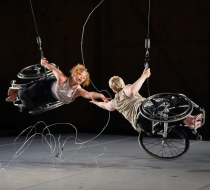CRIPPING CHOREOGRAPHY 1 Favorite
"Rainer’s early choreography celebrated, among other things, ordinary movements: the expressive capacities of kneeling, of shaking your head, of rolling on the floor. And when she went through periods of sickness, those movements became an even more important part of her repertoire. In her 1966 Hand Movie, an 8mm film she shot on her sickbed, we see a dance she choreographed for just her hand, while her body rests.
A younger generation of disabled dancers is building on Rainer’s example. But not content simply to adapt existing choreography to their bodies, these performers are instead out to upend the discipline’s tenets—or better yet, to “crip” them. In her 2003 essay “Queering the Crip or Cripping the Queer?,” scholar Carrie Sandahl writes that the verb “to crip” means to probe “mainstream representation or practices to reveal able-bodied assumptions and exclusionary effects.” In other words, to crip is to refigure something, breaking down any exclusionary barriers, and in so doing, to articulate disabled pride. These dancers treat impairment as a generative, artistic force, highlighting what is unique and beautiful about the way they move." -Emily Watlington







